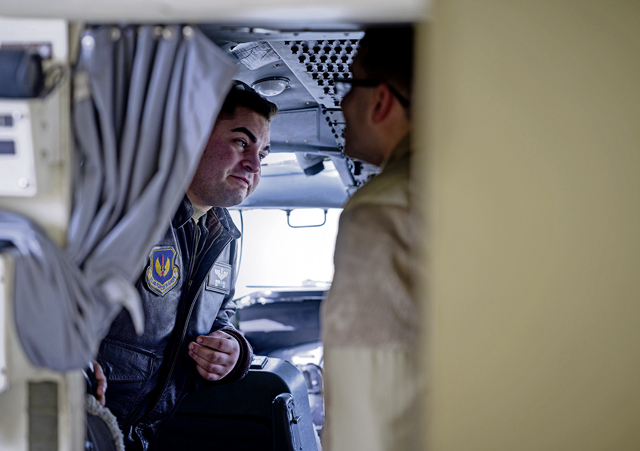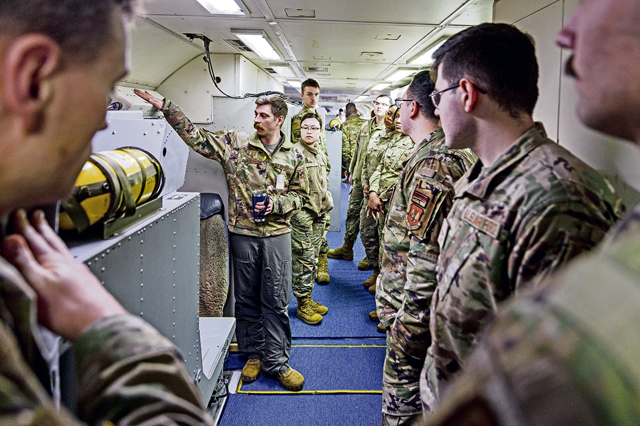
The 10th Expeditionary Airborne Command and Control Squadron hosted members of Team Ramstein for a tour of the Northrop Grumman E-8C Joint Surveillance Target Attack Radar System aircraft at Ramstein Air Base, March 17, to familiarize the base with the JSTARS’ mission.
This tour provided U.S. Air Forces in Europe – Air Forces Africa, NATO Allied Air Command, Distributed Ground System-4, the 603rd Air Operations Center, European Partner Integration Enterprise and 86th Airlift Wing personnel a rare opportunity to see inside the E-8C aircraft.
“The event was an opportunity for Ramstein Airmen to see a glimpse inside this iconic platform that has provided command and control, airborne intelligence, surveillance, and reconnaissance support to combatant commanders since its first deployment in Operation Desert Storm,” said U.S. Air Force Lt. Col. Jeremy Sherman, 10th EACCS commander.

The 10th EACCS is a deployed squadron composed of total force Airmen from 10 units assigned to the 461st Air Control Wing, 116th Air Control Wing and 78th Air Base Wing at Robins Air Force Base, Georgia. It is uniquely composed of aircrew, support, maintenance and security forces Airmen. Deploying with this team is the first time many are working alongside these other career fields.
“I am incredibly proud and continuously impressed by the amazing work of the deployed members,” said Master Sgt. Dusty Surber, 10th EACCS senior enlisted leader. “Such as supporting training exercises and events demonstrating the U.S.’s steadfast commitment to NATO allies, enhancing interoperability with multinational partners and deterring any actions that could destabilize regional security.”
Since being aligned under the 86th Operations Group in 2019, the 10th EACCS has accomplished missions in support of U.S. European Command’s priorities in addition to supporting the U.S. and NATO allies. Airmen assigned to the 10th EACCS benefit substantially from a robust working relationship with mission partners at Ramstein and across the operational European theater.

“We have a diverse team,” said Surber. “Everyone from the maintainers battling the harsh elements, to the defenders keeping the people and jets safe and secure, to the mission planning cell and support personnel helps ensure every mission is met and exceeds the needs of the ISR community. I cannot say enough about this amazing group of professionals and crew members who courageously fly these sorties. Despite facing numerous challenges, the 10th EACCS has managed to perform at a historical level, truly doing more with less.”
The 10th EACCS was first stationed in Europe as the 10th Airborne Command and Control Squadron on Jan. 1, 1970, flying the EC-135H Airborne Command Post on alert for the U.S. commander-in-chief Europe until its inactivation on Dec. 31, 1991.
Since the 10th EACCS has been deployed to Ramstein, they have flown 293 sorties in support of numerous NATO operations and coalition exercises, totaling nearly 2,200 hours and averaging more than 7 hours per sortie.
“This tour was a chance to celebrate the new relationships we have built with Airmen from our base and allied partners,” said Lt. Col. Renee Summers, 10th EACCS chief of staff. “It brings us together to thank them for their collaboration and contributions in theater as well as deepen their understanding of the JSTARS mission and capabilities.”
The JSTARS aircraft is in its twilight years after three decades of dedicated and decorated service in support of countless operations. In December of 2021, the U.S. Air Force authorized Air Combat and Command to start divesting the JSTARS fleet, beginning with four aircraft last year.


